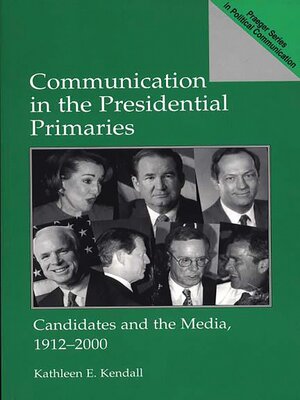Communication in the Presidential Primaries
ebook ∣ Candidates and the Media, 1912-2000 · Praeger Series in Political Communication
By Kathleen E. Kendall

Sign up to save your library
With an OverDrive account, you can save your favorite libraries for at-a-glance information about availability. Find out more about OverDrive accounts.
Find this title in Libby, the library reading app by OverDrive.



Search for a digital library with this title
Title found at these libraries:
| Library Name | Distance |
|---|---|
| Loading... |
In a comparison of communication in the U.S. presidential primaries of the twentieth century, Kendall examines the role of the candidates and the media during the period of primary elections. Drawing upon information from a broad array of sources, Kendall uncovers communication patterns that transcend time regarding political image, horse race coverage, and negative campaigning. She takes a strong communication perspective, arguing that the verbal context of the presidential primaries is an important factor overlooked in traditional studies.
Topics covered include the effect of party rules on communication, the role of speeches and debates, the role of political advertising, and the media's construction of the primaries in the pre- television era and the age of television. Kendall examines the 1996 primaries in light of patterns discovered in earlier years, and she makes predictions and recommendations regarding the 2000 primaries. With its century-wide scope and the variety of research methods used, the book will be of considerable value to researchers, scholars, journalists and students involved with political communication and American presidential elections.
Topics covered include the effect of party rules on communication, the role of speeches and debates, the role of political advertising, and the media's construction of the primaries in the pre- television era and the age of television. Kendall examines the 1996 primaries in light of patterns discovered in earlier years, and she makes predictions and recommendations regarding the 2000 primaries. With its century-wide scope and the variety of research methods used, the book will be of considerable value to researchers, scholars, journalists and students involved with political communication and American presidential elections.







